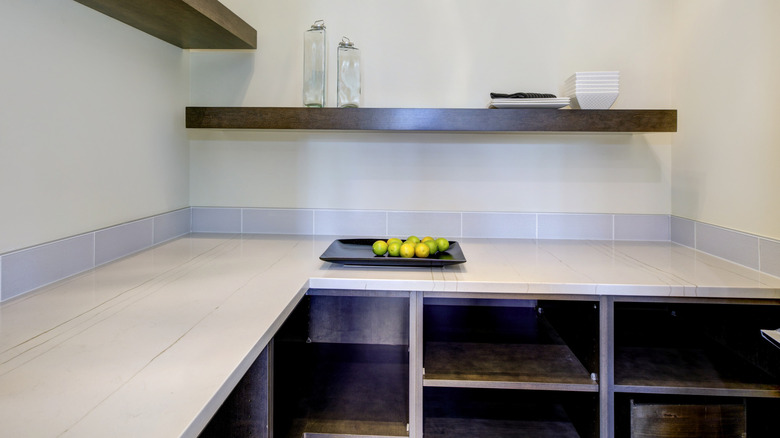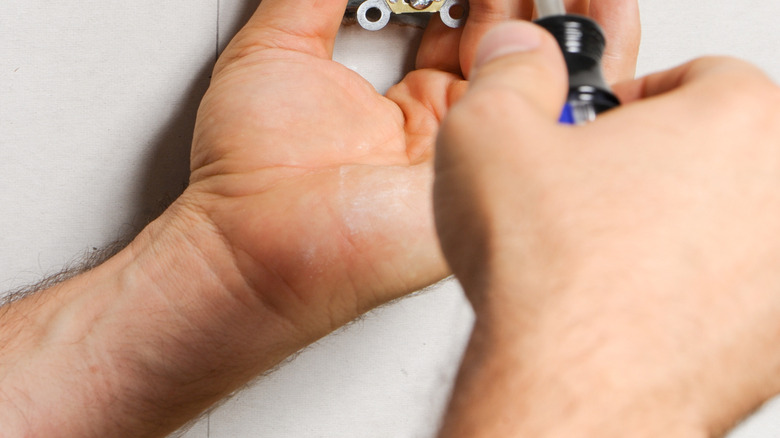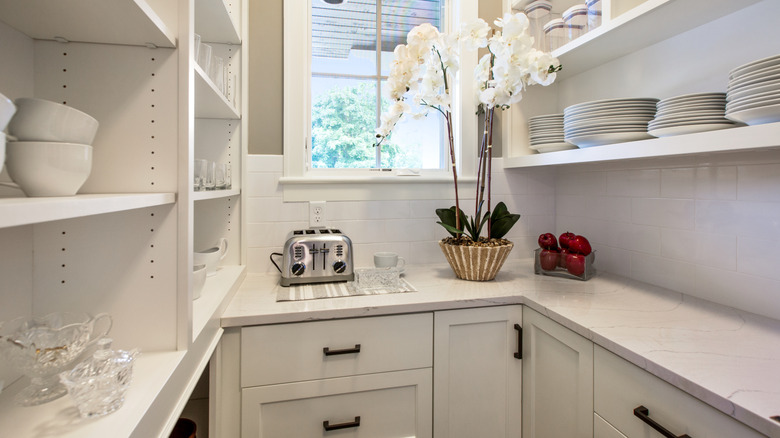Transform A Builder-Grade Pantry Into A Butler's Pantry With These Simple Renovations
We may receive a commission on purchases made from links.
Do you already have a pantry in your home that you're ready to update? If so, why not take your regular pantry and convert it into a butler's pantry? No, you don't need a butler or to live in a mansion for this type of pantry. This conversion is the perfect project for anyone who uses a lot of appliances, entertains a lot, or is running out of space in the kitchen.
So, what exactly is a butler's pantry? This pantry is a walk-in space that may have a small sink and other highly useful appliances, like a microwave, fridge, and extra storage. It differs from a typical pantry that usually focuses on shelves to store food and other dry items. Thanks to the "Builder Grade Pantry Hack" video from the eternalharvestdecor, converting a typical pantry into a butler's pantry can be a simple process that allows you to reuse existing materials in the current space.
From the existing shelves to the light source, eternalharvestdecor masterfully avoids spending too much money on the conversion. She starts to DIY a stunning butler pantry by removing the bottom two shelves and placing them at a lower level. Then she removes the existing light switch and converts it to a power source for the appliances that will go on the counter she builds from 2x2s screwed into studs and pine project panels from Home Depot. She further enhances the new countertops by staining and sealing them. She finishes things off by installing a toe kick drawer for her cookbooks.
Adding power to your butler's pantry
As long as there is a switch in the pantry, you can add an outlet as @eternalharvestdecor does in her butler's pantry. Another youtuber, @DIY-BRY, provides a demonstration on how to add an outlet away from the existing switch. Knowing how to do so may come in handy if the switch is in an inconvenient location after adding a counter.
After checking for a stud, you can cut a hole for the junction box to sit in where there is no stud. Fish tape lets you run the wire from the switch to the new outlet. Plan to get wire strippers, nuts, and a new faceplate. Mark off where you want to cut the hole for the junction box by tracing around it when pressed against the wall. Use a box cutter to cut out the drywall and fit the junction box inside.
Turn off the power, remove the faceplate, and locate the wires on the existing switch. Run one of the wires down until it comes out of the newly cut junction box hole. Expose some of the wires coming out of the junction box using wire cutters. Then, attach those wires to the new outlet and add the faceplate.
What appliances are ideal for this pantry?
As you build out your butler's pantry, you may wonder what to add to it. It's an ideal place to host your small kitchen appliances like toasters, and you can kick things up a notch with some built-in ones. Matter of fact, some people are using their butler's pantries almost as a second kitchen, and with the right upgrades, you can do the same. Since this pantry is often used to plate up food, it makes sense to also include a built-in dishwasher to avoid having to carry empty dishes back to the kitchen. Just make sure to plan for plumbing lines.
Should you add an oven to this space? A traditional oven, toaster oven, or microwave can quickly reheat something before taking it out to the dining area. In addition, you may want to consider a warming appliance like the VEVOR Hot Box Food Warmer available for $279.29 on Amazon. You can even pre-warm plates, just as some restaurants do to serve food on.
Another suggestion: Built-in coffee machines are one of the trends more homeowners are investing in, especially coffee lovers who love to impress guests with custom espresso drinks. If it takes up too much kitchen space, the butler pantry is perfect for it.


